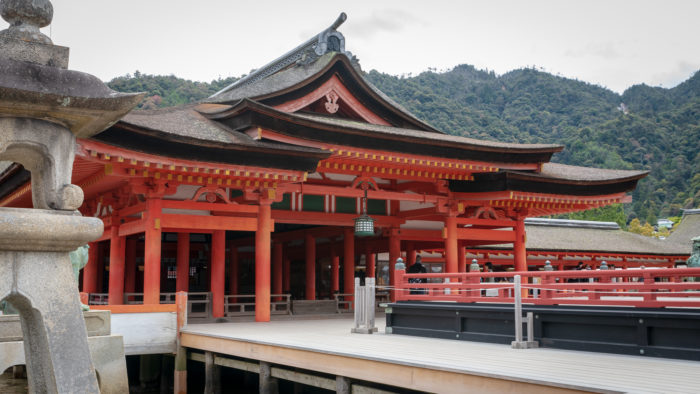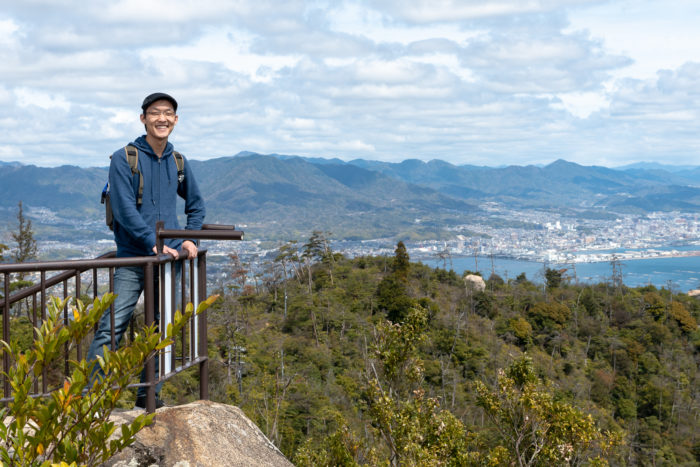After four full days in the Kansai region, we packed up our bags and rode the bullet train to Hiroshima. I really didn’t know that much about the region besides the food, Itsukushima Shrine, the atomic bombing, and the general consensus that it’s worth the visit. It is perhaps thanks to this general ignorance that this brief stay became the most pleasant surprise, yielding the most vivid experiences of the entire trip.
Miyajima Island


Itsukushima shrine and its surrounding area on Miyajima island are a lovely experience. While it is a rather busy tourist spot, there’s a lot of it to go around, so it never feels suffocating. There’s a great view of the Torri gate anywhere along the shore, and there’s a good deal of open space in the shrine itself to take in the sights without feeling cramped. That is, unless you absolutely must take photo at the farthest end of the shrine closest to the Torri gate, in which case there is going to be a line.



The presentation of the shrine is dependent on the tide. At low tide, the ground beneath the complex is fully exposed, and visitors can go right underneath the Torri gate on foot. At high tide, the base of the structures is submerged in water, giving them the “floating” appearance. When the tide is high and the light is good, the view of the vivid red gate against the blue sky and blue sea is a handsome one indeed. Make sure to look up the tide forecast beforehand if you plan to visit.



Around the shrine is an impressive assortment of souvenir shops and restaurants. The region is known for oysters, which isn’t my favourite food but I can confirm they’re great both grilled and fried here. There are also many stores that make maple leaf shaped momiji manju snacks. These treats are typically filled with red bean, and they’re very tasty when fresh. Think bite-sized pancakes with a sweet filling.

Also of note are the deer on the island, who are not accustomed to being fed by visitors and thus do not exhibit any of the gangster-like behaviour of their Nara counterparts.


Confession time: I think Itsukushima Shrine is a bit overrated. Don’t get me wrong: the gate and shrine are certainly photogenic, but they’re not architectural marvels. Instead, what makes them a world-renowned tourist attraction is the scenic surroundings, and the best way to get the full appreciation of that is by going up Mt. Misen, the tallest peak of the island.



The trip up Mt. Misen starts on foot with a short hike through the forest, and the end of which you’ll find first leg of the ropeway. The views from inside the little box would unnerve anyone with a fear of heights, but are otherwise brilliant. After getting off and switching to a larger cable car halfway through, we arrived at the observation deck.


The observation deck gives you a panoramic view of the Seto inland sea area. Small islands dot the waters, and the city of Hiroshima is clearly visible in the distance. There are little tubes built into the handrail that points to specific island when looked through, along with a description of the island.

The weather was perfect when we were there, and the sea was dazzlingly blue. It brings out the anime cliche of kids shouting “Umi da!!” at the sight of the sea, in a way that city waterfronts in Tokyo and Osaka do not. There’s a feeling of having fled the city, despite the fact that an entire tourist town sits at the foot of the mountain and Hiroshima is clearly within view. Of all the places we’ve been in Japan, the view here is definitely the best.
Hiroshima

Miyajima is a tough act to follow, but Hiroshima proved to be an equally memorable experience, though for distinctly different reasons. The first place we visited was the Hiroshima Peace Memorial Museum. One of its buildings was under renovation at the time, so some exhibits were temporarily moved into the east building that was still open. I didn’t take many photos here because it felt inappropriate given the subject matter, so for this section of the post I’ll share photos from the Peace Memorial Park, on which the museum is located.

There were vivid descriptions of the blast and its short term and long-term aftereffects, which were made especially grim and upsetting by the abundance of first-hand accounts. I had known beforehand about some of the artifacts on display, but what I didn’t know were the descriptions accompanying them from the relatives of the deceased.

For example, it’s one thing to see what a nuclear blast did to a child’s tricycle, but it’s another to read the words of the child’s parents and how they originally buried the tricycle with the child in the backyard so that the child could possibly still play with it after death. It was these emotional connections that made the museum so memorable.
I also enjoyed reading about Hiroshima’s rebuild in the aftermath of the war. To return from total destruction to a bustling metropolitan city is an inspiration in of itself.

Finally, the museum also outlines the progress toward denuclearization in the decades since the bombing, culminating with U.S. President Barack Obama’s visit in 2016. Given the grave stakes of nuclear war, it is especially galling that Obama’s successor would casually boast and threaten nuclear destruction.

The museum is not just a warning against nuclear weapons, but also against modernized total war in which the destruction of civilian populations is fair game. It makes one appreciative of the relative peace we enjoy in an era of such destructive potential. Whether or not you feel the bombing was justified, it is my firm belief that if everyone on earth visited the Hiroshima Peace Memorial Museum, the world would be a much more empathetic place.

Outside of Peace Museum is the Peace Park. Located in the heart of the city. It is adorned with memorials to the victims of the bombing.

Of special note is the A-Bomb dome, which was right beneath the epicentre of the blast. The roofs and floors were completely blown out, but because the force came almost directly above the building, the walls and the skeleton of the dome itself remained largely intact. Eventually, the A-bomb dome was preserved, and today it’s a tragically beautiful echo of the city’s past. The sight of the dome set against the city sprawl in the distance is striking — a tableau of Japan’s postwar miracle.
Lasting Impressions

During the stay in Hiroshima, we ate at Okonomiyaki-mura, a four-story building packed with dozens of restaurants all serving Hiroshima’s signature dish, a layered extravaganza of batter, pork, veggies, noodles, egg, and whatever you else you want. Behind the counter was a Chinese immigrant working with an older Japanese man, who was very proud of his growing phrase-book of greetings in foreign languages. On the TV screen is a baseball game featuring the Hiroshima Carps, where foreign players were playing for both teams. I made some chit-chat with our hosts in a garbled mix of Japanese, English, and Chinese.

Of course, the real world is more complicated than a tourist trap restaurant or a baseball game, but this dinner-time experience gave me hope. Even with the contentious history between Japan and its neighbours, as well as bloody war that culminated in Japan’s total defeat, people from opposing sides can and do eventually get along, in spite of all the historical inertia against it. Just as it is important to remember the past, it is also important not to be trapped by it, so that we might get along better in time, little by little.

